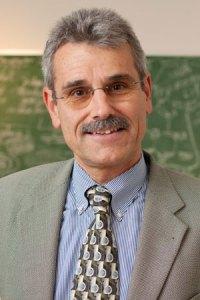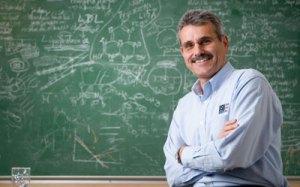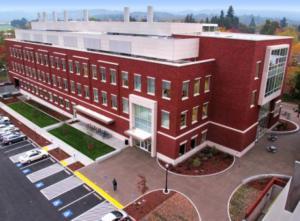
Balz Frei
Oregon State University is turning 150 years old in 2018, and already several projects are being developed to mark the occasion. One of them is a major oral history initiative that is capturing the stories of a wide array of alumni, faculty, staff, administrators and friends of OSU.
Several months ago, the project conducted an interview with Dr. Balz Frei, who has led OSU’s Linus Pauling Institute since 1997. A Swiss native, Frei worked under Bruce Ames at UC-Berkeley before moving on to Harvard, the Boston University School of Medicine and, ultimately, Oregon State.
Frei’s research has always focused on the processes fundamental to human health. During his time in Berkeley, Frei became interested in vitamin C and met Linus Pauling. His later work has focused on oxidative stress and the role that it plays in atherosclerosis. He has also investigated arterial function and potential dietary compounds – including vitamin C – that might help prevent oxidation of LDL cholesterol.
Under Frei’s leadership, the Linus Pauling Institute has stabilized its funding base, hired several principal investigators and made substantial contributions to the published literature on subjects relating to nutrition and optimal human health.
In 2011 the Institute celebrated a major milestone with the completion of the Linus Pauling Science Center. This 105,000 square foot facility, built for $62.5 million, is the largest academic facility project in OSU history. Now housed in this new space, LPI continues to conduct research on cardiovascular and metabolic diseases, healthy aging, and cancer chemoprotection, and engages in public outreach through its Micronutrient Information Center and Healthy Youth Program.
Excerpts from Frei’s oral history interview, including his memories of meeting Pauling, his sense of Pauling’s vitamin C work, and his vision for the future of LPI, are included below the cut.

On Pauling’s Vitamin C Work
[M]y view was, back then, that Pauling did very interesting work on Vitamin C. And I remember shortly after I came to the United States in ’86, I went to a conference in Washington. And the book How to Live Longer and Feel Better had just been published, and I found it there in a book store and I bought it right away, and I read it. And I was fascinated. I thought it was absolutely intriguing, what he was saying in that book. Obviously it focuses a lot on Vitamin C, and then it focuses a lot on dietary supplements, and probably puts too much emphasis on supplements and not enough on diet itself. But I was very, very intrigued by that book.
But I also felt that he was going a little too far. And he made quite extreme statements, or maybe you could call it hypotheses, that Vitamin C can cure the common cold, and it can treat cancer, and may also be useful in heart disease. You know, there were certain things that panned out, but many of his predictions didn’t quite pan out. And because he was so passionate and almost extreme about Vitamin C and its role in the common cold, in particular, I think in the end, among the scientific community, he may have actually caused more harm than good for Vitamin C, because they felt he was just getting too far out. He was too extreme. And many of his predictions, or his hypotheses didn’t actually quite work out the way he had sort of envisioned.
[…] And still nowadays, among scientists, they are kind of critical when it comes to Vitamin C. They think, well, yeah, it’s Pauling, and he just overdid it. We don’t think there’s anything special about that Vitamin. […] Unfortunately, because Vitamin C is an absolutely fascinating vitamin. And it is, as I mentioned, a really, really good antioxidant, and I think it’s the best antioxidant we get from our diet. And being an antioxidant has many important functions in the body, because oxidative stress and oxidative damage is a contributing factor to many chronic diseases.
It’s not the only factor, of course. All diseases are multi-factorial with a few exceptions, but if you can lower oxidative stress and oxidative damage, you do have a lower risk of certain chronic diseases. I mean, there’s no doubt that oxidative DNA damage is mutations, which in turn can cause cancer. And if you can prevent oxidative DNA damage with Vitamin C, or other antioxidants, then you should see the consequences, in terms of a lower risk of certain types of cancer. And the same with heart disease, you know, if oxidation of LDL really plays a role atherosclerosis, which is still somewhat controversial. But my work showed that the best antioxidant to prevent LDL oxidation is Vitamin C, because it is so highly reactive, and it is present in human fluids and cells and tissues at fairly high concentrations, or even very high concentrations. So, there must be a role of Vitamin C as an antioxidant in the human body, otherwise we wouldn’t accumulate it in these large concentrations.
And so there certainly is something to all these ideas that Linus Pauling had, but he just went a little too far, I think, and he got ahead of the science and the evidence. And you know, he was the first member of the National Academy of Sciences who had a paper rejected by the Proceedings of the National Academy of Science, which back then was unheard of, because the members could just send in their papers and they would get published without even being peer reviewed. That’s no longer the case, but he was the youngest member ever to be in the National Academy of Sciences, in his early thirties, but he also was the first one to have a paper rejected by PNAS.

On Meeting Pauling
[…] I met him twice. The first time was at the Institute in Palo Alto, the Linus Pauling Institute of Science and Medicine. And he had invited me, together with Bruce [Ames], to come to the Institute and give a seminar. And for me, it kind of was a job interview. They wanted to hire me. I was at the end of my post-doctoral fellowship looking for jobs. And so they were interested in me, and asked me to come and give this seminar. And I did that back to back with Bruce.
And this was the day of the big earthquake in the Bay Area, in 1986 [...] I’m always joking that it was an earth-shattering experience to meet Linus Pauling for the first time. And it truly was. I was in the office of Steve Lawson […] I was sitting in his office, and we were talking about science, and what’s going on at the Linus Pauling Institute of Science and Medicine. And all of a sudden these eucalyptus trees outside the window started to kind of dance back and forth. First I thought it was some strong wind, but then I realized these big trees wouldn’t move in the strongest wind.
And so it was the earthquake. We heard all the glassware shattering, and things coming down from the shelves in the laboratories, and then we realized, ‘Oh, this is an earthquake.’ Got up and ran out, which you shouldn’t do. You should crawl under a table, or under the door frame, but no, we just ran out as quickly as possible, ran down the stairs, and out into the big parking lot behind the building. And I remember there were these waves going through the parking lot. It lasted for about 45 seconds or so, and then everything was totally quiet after that. Nobody was saying anything. Everybody was kind of in shock. There were no cars moving. It was very eerie.
[…] I gave my seminar, and then talked to a lot of the people in the Institute, because, as I mentioned, kind of a job interview. […] And then when I had to go home there, I had to go all the way south to San Jose, and it took me about three hours to get back to Berkeley.

The Linus Pauling Science Center at Oregon State University.
On the Future of the Linus Pauling Institute
What we really want to enhance now is this focus on health span. I mean, we have been doing this, in a way, already for the last seventeen years, but to bring that out a little bit more pronounced, and really focus more on that as a unifying kind of mission, or theme, of what we’re doing. So, health span as opposed to life span is not only how long you live, but how well you live. And health span is the time in your life when you’re free of chronic disease, but also free of what’s called deficits of daily living. So it’s not just absence of disease defined as health, but it’s also optimum health: how well your whole body, all the systems in you body, are working. Like immune function—is that at the optimal level, and are you protected against infectious diseases as effectively as you can?
And then, how resilient are you? How well is your energy metabolism, and all those things that you know, have different degrees of functioning well, or not so well, which is not manifested as absence or presence of disease, but being more vital, more fit, and having optimum health, not just good health.
And so this time of optimum health and absence of disease is what we call health span. And what we are trying to do is get the health span closer to the lifespan, so that the gap between when your health starts to decline, and you have certain daily deficits of living, and you also have signs of chronic disease, that this time, between those deficits and the diseases showing up in your life, to when you die—that gap is getting smaller and smaller.
The ideal world would be where your health span is equal to your lifespan, and you basically die of old age without having suffered before you die. That would be the perfect world. But unfortunately in this country, this gap between health span and lifespan is actually becoming bigger, because we are living longer, but we are not necessarily living better. […] So it’s a long life, but you want to have a good life, too. And in the United States, and around the country, and around the world, we are living longer, but we are not keeping up with the health span, compared to the lifespan. So how can we close that gap? That’s kind of what we are addressing in the Institute.
Check out the full Balz Frei oral history interview.
